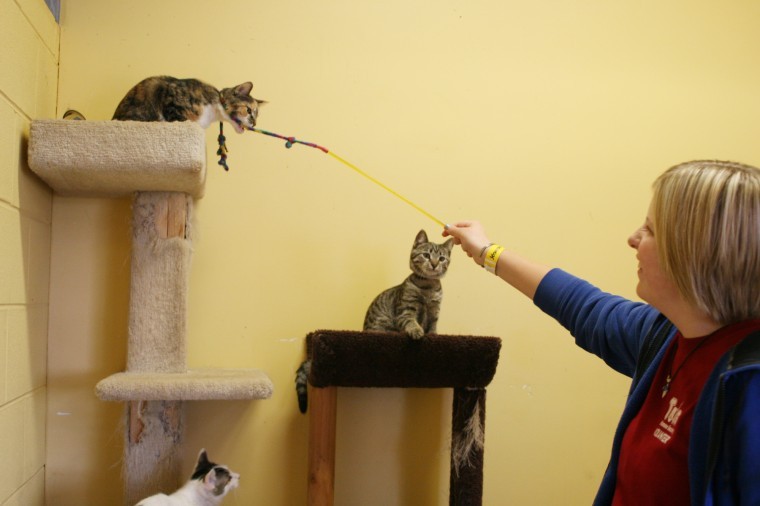Shelter animals may require more time and care after adoption
Northern Star Staff
Alison Pacey, 14 Genoa, plays with a few cats at Tails Humane Society, 2250 Barber Greene Road, as a part of her volunteer hours.
October 23, 2011
In August 2010, sophomore pre-communication major Shucreeia Robinson took the advice of a friend and decided to adopt a rabbit locally at TAILS Humane Society.
Robinson is not alone in choosing adoption from local shelters. Illinois Department of Agriculture data from 2006 shows TAILS, 2250 Barber Greene Road in DeKalb, adopted out 698 dogs and 940 cats and the DeKalb County Animal Shelter adopted out 242 dogs and 137 cats. However, some NIU students find pet adoption more problematic than expected.
Shelter animals come from a different environment than other pets and have unique needs and problems, said Roberta Shoas, manager of the DeKalb County Animal Shelter, 16173 Baseline Road in Genoa.
“A perfectly healthy animal in an animal shelter can develop an illness based on stress of moving to a new environment that has nothing to do with life in the shelter. It’s situational,” Shoas said.
When Robinson went to TAILS, she noticed the rabbit she was told was most adoptable and people-friendly seemed to have an injured foot. Assured by TAILS staff that the rabbit had just come off antibiotics the day before, would recover soon and only needed its foot bandaged, Robinson took home the bunny and named him Elliot.
With a voucher issued by TAILS for a free check-up by a veterinarian of Robinson’s choice, she took Elliot to Bethany Animal Hospital, 2400 Bethany Road in Sycamore. There, she was told the foot would need more time to heal, Robinson said.
Robinson called TAILS to explain the situation and was told they would assist in bandaging the foot, or she could relinquish the animal back to the shelter.
Robinson instead eventually turned to Bethany Animal Hospital to seek treatment for Elliot, but the expense of constant vet bills took its toll. A bandaging appointment could cost anywhere from $9 to $181, depending on what needed to be done. And the antibiotics needed cost $40 a month, Robinson said.
“I would have to sacrifice certain things to make sure the rabbit had the antibiotics,” Robinson said.
Eventually the foot started to heal, but during a brief period of time when she could not afford the antibiotics, the rabbit’s condition worsened, Robinson said.
She was told that the last resort for curing the animal would be to get a $1,000 culture test to see what kind of bacteria was deteriorating the foot. Another option was to amputate the infected foot, which would cost $2,300.
Robinson could not afford either option and had to make the decision to euthanize Elliot.
“It’s hard to get by as a college student as it is, and when you add a sick and dying animal, your best friend, it gets to be so hard,” Robinson said.
Heather Brown, Doctor of Veterinary Medicine at Bethany Animal Hospital, said Robinson brought Elliot in shortly after his adoption.
According to Brown, cases like Elliot’s can sometimes start as something small and turn into a bigger problem.
“I don’t think this was anything that was TAILS’ fault,” Brown said.
With the case of Robinson and her rabbit, TAILS executive director Beth Drake made it clear that a different perception was held by the TAILS vet who treated the animal.
“Our vet was particularly frustrated with this case,” Drake said. “[The vet’s] assessment is that the foot would have gotten better had the directions been followed. All along, the opinion was that the foot was not being treated appropriately,” Drake said.
In the end, Robinson spent nearly $1,000 on care for Elliot.
“I felt it was unfair to relinquish a sick animal that needs better care and lie about the animal’s current state of recovery,” Robinson said.
TAILS has an in-house veterinarian that assesses the health of the animals that come into the shelter, Drake said.
“Every animal that is released from us has been examined by our vet and a member of our management staff,” Drake said. “They didn’t have symptoms or apparent other issues when they were adopted out. If symptoms occur later, there’s not a whole lot we can do.”
Adopting an animal, especially one with a past medical condition, is a big responsibility, Drake said. Often times, students aren’t prepared for the costs and the risks involved. Drake encouraged those considering adoption to thoroughly think it through and do research.
Robinson has since adopted another rabbit from No Splitting Hares, a rabbit-specific sanctuary in Algonquin. Regardless, she can’t forget Elliot.
“He was a really good rabbit,” Robinson said. “This experience has taught me never to take someone at their word about something I need to invest in.”







